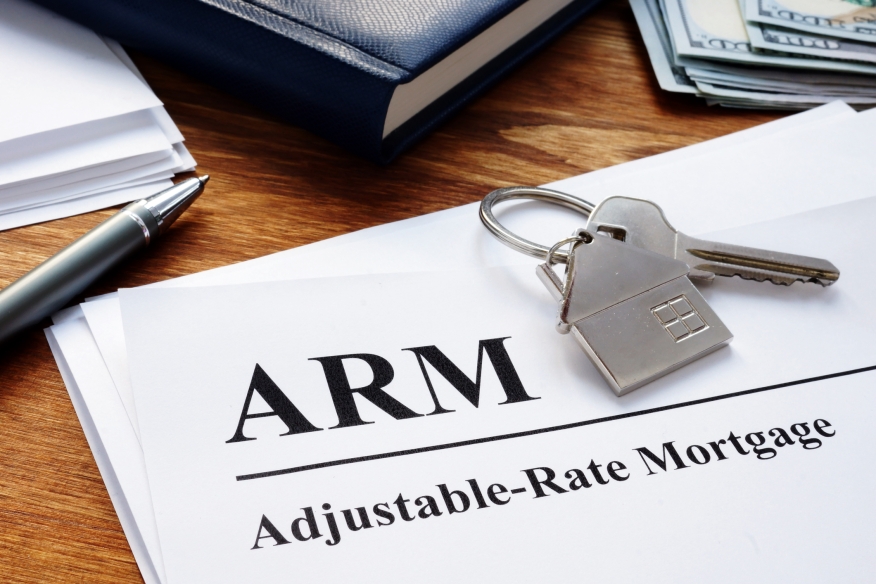
Financial Profile Of ARMs Borrowers Reduces Risk Of Housing Crash

Zillow says today's ARM borrowers have higher incomes, place larger down payments.
- The share of adjustable-rate mortgage (ARM) applications is the highest it's been in 15 years.
- Buyers who recently financed a home purchase with an ARM typically make nearly $75,000 more than borrowers overall, and their typical down payment is more than twice as large.
- Black mortgage borrowers have been more risk-averse in their use of ARMs and have not reaped the potential rewards to the same degree as borrowers of other racial groups.
Adjustable-rate mortgages (ARMs) are becoming more common as home buyers hunt for ways to save money with today's higher mortgage rates.
The result is that borrowers using ARMs are more likely to be affluent households with larger down payments, a new Zillow analysis finds, adding that this reduces the risk of a housing market crash.
The share of applications for ARMs rose to 12.6% in June before dipping slightly to 12.2% in July, Zillow said. Those two months mark the first time the share of ARMs has risen above 12% since August 2007.
ARMs usually offer a lower interest rate than a standard 30-year, fixed-rate mortgage during the introductory period — ranging from three to 10 years — which is attractive when mortgage rates are high. The interest rate on an ARM loan can rise or fall after the introductory period expires, bringing some long-term uncertainty for the borrower.
"Housing market conditions and the profile of ARM borrowers should bring comfort to anybody scarred by the memory of risky lending practices during the Great Recession," said Zillow senior economist Nicole Bachaud. "It's important not to confuse some added risk for an individual borrower with risk to the housing market as a whole.
“Borrowers today,” she continued, “are more financially prepared for home buying, and the housing market has a much stronger outlook than the last time ARMs were this popular. While not the best option for every buyer, ARMs can be beneficial for households on solid financial footing that can stomach the possibility of higher payments down the road."
ARMs Not the Same As Subprime Loans
The growing popularity of ARMs may remind some people of the subprime mortgages that were issued to borrowers who could not qualify for conventional mortgages in the run-up to the Great Recession. Many subprime mortgages acted similarly to ARMs, in that the monthly payments were initially low, then increased in later years. That’s where the similarities end, however. Lending standards are now much tighter.
Home buyers who recently financed their purchase with an ARM appear to be better positioned than borrowers overall, with higher median incomes and larger down payments, Zillow said.
The median income of buyers who received an ARM loan was $165,000 in 2021, compared to $91,000 for all borrowers. And the typical ARM borrower put 23.6% down — reducing the amount borrowed — while the typical borrower overall put down 10%.
Given this, Zillow said, it's likely that today's typical ARM borrower would be able to withstand increased monthly payments if mortgage rates rise.
In addition to reformed lending practices, housing market conditions are also much different than they were 15 years ago. Rapid home price increases in the 2000s were due in part to artificially inflated demand from buyers who were not financially ready for a home purchase, Zillow said.
In contrast, today's buyers are well qualified, and there are likely many more financially well-off buyers who were unable to buy during the pandemic’s white hot market who now want to pounce if the right home at the right price comes onto the market.
While it's nearly impossible to predict inventory levels five years into the future, the inventory shortage is a long-term problem that does not appear to be on the verge of righting itself, Zillow said. That means, even in the unlikely event that a large number of ARM borrowers were unable to afford their mortgage payments in a few years' time and were forced to sell, the realities of supply and demand would mean it's possible that a supply influx would be swallowed up by eager buyers, limiting any impact on home prices, it said.
Black Borrowers 'Risk-Averse'
While many recent borrowers have benefitted from low mortgage rates and the benefits offered by ARMs, Black mortgage borrowers have been more risk-averse in their use of ARMs and have not reaped the same rewards. ARM loans approved for Black home buyers were for a median property value lower than for Black borrowers overall, a reversal from all other racial groups included in the analysis.
"Adjustable-rate and subprime loans disproportionately harmed Black homeowners during the foreclosure crisis," Bachaud said. "Black mortgage applicants, then, have reason to be more risk-averse in their use of ARMs, particularly in a time like today when housing market conditions are changing so quickly.
“While the popularity of ARMs is rising and the potential benefits are greater for the right type of buyer,” she continued, “the data shows Black home buyers are less willing to accept the added risk after facing greater obstacles to qualify for a mortgage, another signal that lending is a long way from equitable."
Black and Hispanic homeowners were disproportionately harmed by the mid-2000s housing crash, and the Black homeownership rate has yet to recover, Zillow said. The data indicates Black home buyers — who often have more difficulty securing a mortgage — have been more wary of taking on financial risk than home buyers of other races, and some may be missing out on the benefit of the lower introductory interest rate.



